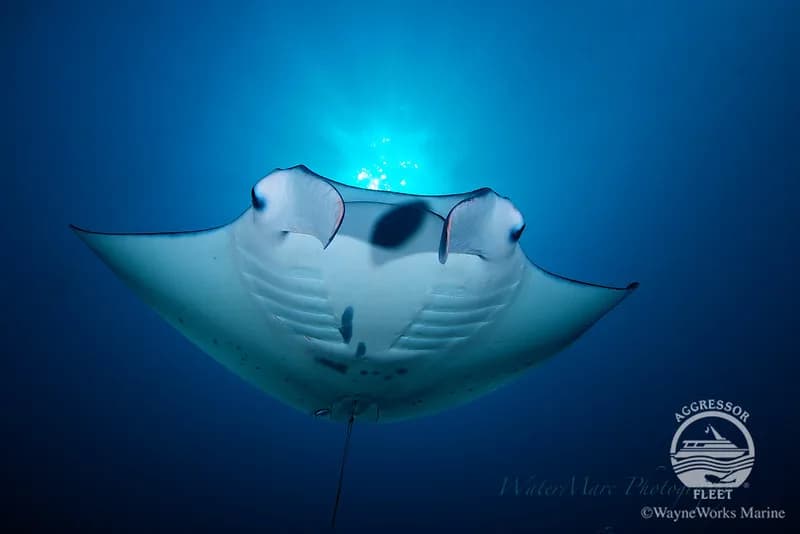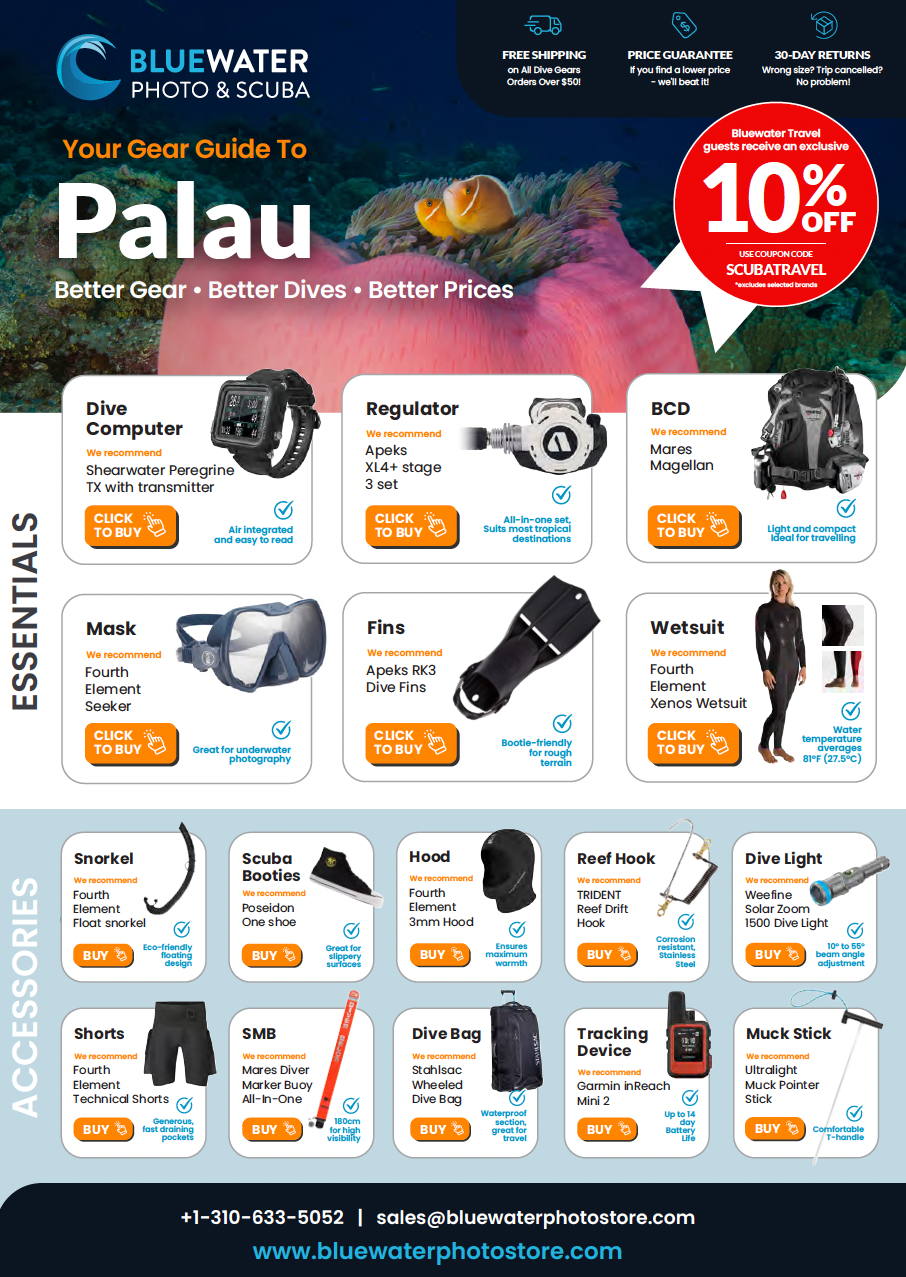We Know Because We Go! | Book with a 5-Star Team,| Trusted by 10,000+ Divers
Best Scuba Diving in Palau
Palau diving is unique, thrilling and very diverse. Hook into the reef or drift through the channel as sharks, mantas, and large schools of fish coast by in the current.

Destination Highlights
Average flight time from LAX
13
Scuba Dive Level
All Levels
Visibility
50 to 100 feet (15 to 30 meters)
Average Water Temperature
82
Pelagic Encounters
Stunning Reefs & Corals
Scuba Diving in Palau
Palau Diving Highlights
Explore historic World War II wrecks, or soak up the view as shafts of sunlight pierce the transparent waters of undersea caverns at the Blue Hole. And don't forget a visit to the world-renowned Jellyfish Lake to complete your trip.
An idyllic paradise above and below the surface, topside Palau treats scuba divers to the archipelago's emerald green jungle-covered Rock Islands surrounded by clear turquoise waters.
When To Go
Palau scuba diving is great year-round; however, the dry season, which lasts from October to May, is considered to be the best time to dive Palau.
More on the best time to dive Palau
Palau Liveaboards And Dive Resorts
Palau scuba diving can be done via liveaboard or resorts and dive operators. There are a good number of liveaboards to accommodate a range of budgets, and many resorts and dive operators to create your perfct custom package. Liveaboards often include up to 5 dives per day, while most land-based operators would offer 3 boat dives per day plus additional dives from their jetty. Land-based dive shops have access to all the dive sites liveaboards visit in Palau, so the choice comes down to your preferences.
Palau is often visited in conjunction with Yap and Truk Lagoon. Learn about getting to Yap from Palau with direct flights from Pacific Missionary Aviation.
Diving Information
Marine Life, Diving Conditions, And Best Dive Sites.
Intro To Palau Diving
Palau scuba diving involves a lot of drift dives and reef hooks. After your descent, typically 50 to 60 feet, your dive will continue as either a gliding drift over the reefs and along walls as the current carries you, or you will stop and anchor yourself to a sturdy outcropping of rock and let the current bring the reef life to you. A reef hook is essentially a big fishing hook with the barb removed attached to a 3-5 meter rope.
The hook goes into a dead part of the coral reef and the other end attaches to your BCD. Reef hooks are fairly well accepted in Palau, but only at specified sites that have consistent current and an abundance of dead coral to hook into.
Perhaps the most popular of all reef hook dives are at Blue Corner, where a lot of current around the point brings in the big fish. Sharks, jacks, tuna, and resident Napoleon wrasse are often sighted. If mantas are what you seek, head out to the German Channel, where divers rest on the ocean floor while teams of mantas circle above. Palau has a lot of healthy hard coral and a good amount of wall diving.
A typical day of diving in Palau usually involves up to 5 dives a day including a night dive, whether you are staying at a resort or on a liveaboard. For an in-depth look at liveaboard experiences, check out our Palau liveaboard diving guide.
Marine Life & Photography Subjects
Palau's prolific marine life includes big animals and macro life. The strong currents and variable conditions at many dive sites make underwater photography very challenging. It can be difficult to get reef sharks to come close to you while you are hooked in at Blue Corner. Unhooking and swimming down into or over the lip of the reef can get you closer to sharks, but you also risk the ire of other dive groups who fear your bubbles will scare away the wildlife. It's best not to chase sharks - instead, find a good spot where they can swim by you in the current. Photographing mantas in reduced visibility will test your post-editing skills.
Night dives are often the best time to put on your macro lens, as a wide range of reclusive creatures emerges from the reef after dark. This can also be a great opportunity to get close to otherwise skittish fish while they sleep.
Diving Conditions
- Water Temperature: 81-84F(27-29C).
- Visibility: Ranges from 50-150+ feet (15-45 meters). During the dry season, the visibility often exceeds 100 feet (30 meters).
- Depth Range:16-131 feet (5-40 meters).
Palau's Best Dive Sites
We've rounded up some of the best dive sites in Palau. These sites are typically usually included in most liveaboard itieneraries.
1. Chandelier Cave - This site is a large cave with several "rooms". You can enter the cave at 25ft, and surface in several different "rooms". Underwater tunnels allow you to swim from room to room. This is a very cool place, and a good place to take a wide-angle photo with a diver.
It's a very adventurous dive that must be done at the right time of day with an experienced guide with whom you feel comfortable. Bear in mind that this is an overhead environment and there are places where you can't see any light, visibility can drop to zero, and you can have trouble finding your way out. For all of these reasons, this dive should be taken seriously, and participants should be experienced divers, equipped and trained accordingly, preferably at least cavern certified. It is also wise to come equipped with lines & reels as well as backup lights unless you are sure that the dive operator will provide them.
2. German Channel - German channel is famous for its manta rays, but it has much more. This narrow pass separates Ngemelis and Ngercheu Islands, forming a connection between the inner lagoon and open sea. Shallow water, strong currents, and boating traffic make the narrowest portions unsuitable for scuba, but the large area at the channel's mouth offers amazing diving opportunities.
Virtually every sort of tropical marine life can be seen here, but the site is most famous for mantas, eagle rays, reef sharks and many species of schooling fish. Often the best strategy involves settling in a lively area and waiting for the action to come to you. If the current is running, this can also be a great drift dive. Just go with the flow and soak up the sights as you fly effortlessly over the reef. Be extremely cautious when surfacing, however, as boating traffic can be very heavy here. Make sure that at least one member of your team sends up a safety sausage (SMB) on a line before your final ascent!
3. Blue Hole / Blue Corner - These two sites are among the most celebrated in Palau, for good reason. Known throughout the world for its abundance of fish life, Blue Corner is the kind of place where it's possible to see just about anything.
Situated on a current-swept corner of a steep drop-off, it is a natural gathering point for reef fish of every description, dense schools of jacks, snappers and barracuda, and a healthy population of white-tip and gray reef sharks, as well as Napoleon wrasse and many other species.
Eagle rays, mantas, turtles, tuna and wahoo are also seen fairly often, and even billfish, whale sharks and whales make occasional appearances. Within easy swimming distance (depending on the current) is the sister site of Blue Holes. A large cavern with multiple entrances, accessible from the shallow reef top as well as deeper points on the wall. Illuminated by shafts of sunlight from overhead, the view from inside is a memorable experience of sublime beauty.
The spacious main cavern is appropriate for divers of all experience levels, but there is also a narrow cave at 85 ft. that should only be explored by properly equipped and certified cave divers. The reef itself is another attraction surrounding both sites, with colonies of boulder and cabbage corals scattered over the plateau at 45 to 60 ft. Dropping over the wall, you'll find a healthy mix of hard and soft corals, as well as sponges and massive gorgonian sea fans.
Other Palau Dive Sites - Other notable Palauan sites include New and Big Drop Offs, Ulong Channel, Peleliu Wall, and Cut, Mandarinfish Lake and WW 2 Japanese shipwrecks Iro and Sata. There is also a Zero fighter plane in very shallow water, plus countless other reefs and walls.
Best Time To Dive Palau
In general, Palau can be dived year round.
The best time to scuba dive Palau is during the dry season from October to May. The rainy season from June to September brings more wind and rain than usual, though much of it occurs at night. Palau is in the tropics so it does receive a fair amount of rain, but weather patterns here are fairly predictable.
How To Get To Palau
Fly into Roman Tmetuchl International Airport (ROR) in Koror. There are no direct flights from the US—most routes connect through major Asian hubs, typically requiring two stops. Travel time is about 20–26 hours from the western US and 36–40+ hours from the eastern states. We recommend arriving at least one day before diving to rest and rehydrate before boarding your liveaboard or starting day trips.
Other Things To Do In Palau
Palau offers a host of exciting and adventurous non-diving activities, including waterfall hikes at Ngardmau, rock island excursions, sport fishing, speedboat & kayak tours, city tours and more. If you seek nature, kayaking in calm blue waters among the islands is a must-do activity on your non-dive day. Palau is rich with World War II history. Explore Palau's diverse culinary scene if you're staying at a land-based resort.
For history buffs, a trip to Peleliu Island or the German Lighthouse is recommended. The Palau Pacific resort is convenient as a 1-2 day stop either before or after boarding a Palau-based liveaboard boat. It's the island's biggest luxury resort with a lovely private beach.
Practical Information
- Currency: United States Dollar
- Language: The official languages are English and Palauan
- Main Airport Code: ROR
- Time Zone: UTC+9
- Electricity: 120 V 60 Hz; North American plugs.
Recommended Scuba Gear
Download our full scuba gear guide to Palau, Bluewater Travel guests receive 10% OFF! Click the image below to download (PDF).

